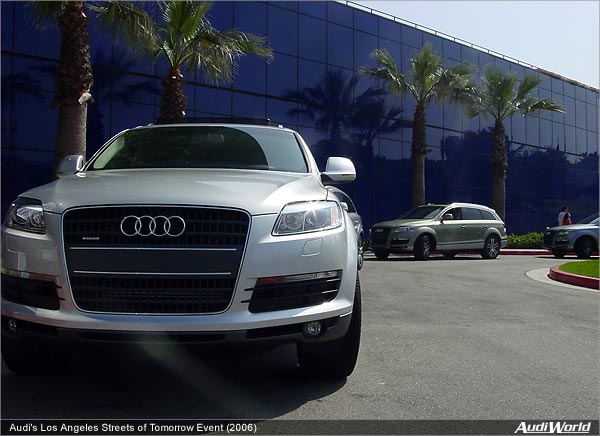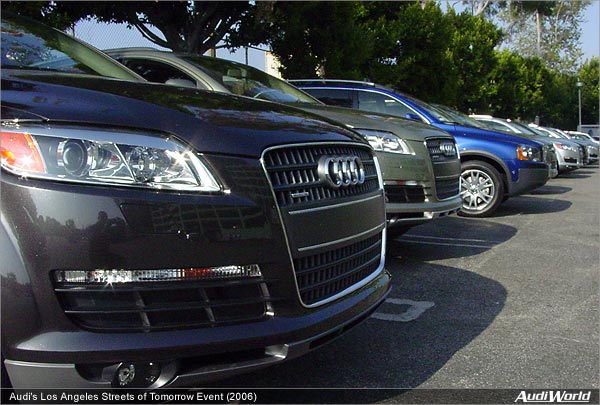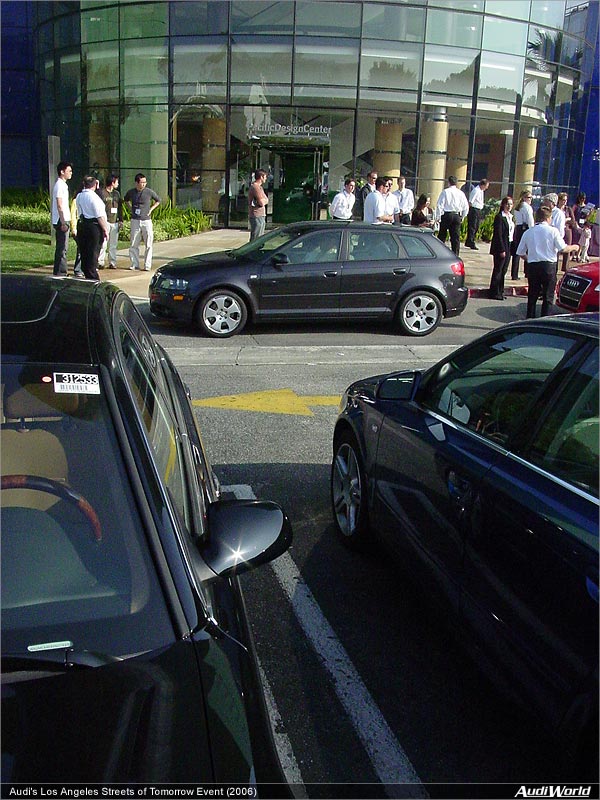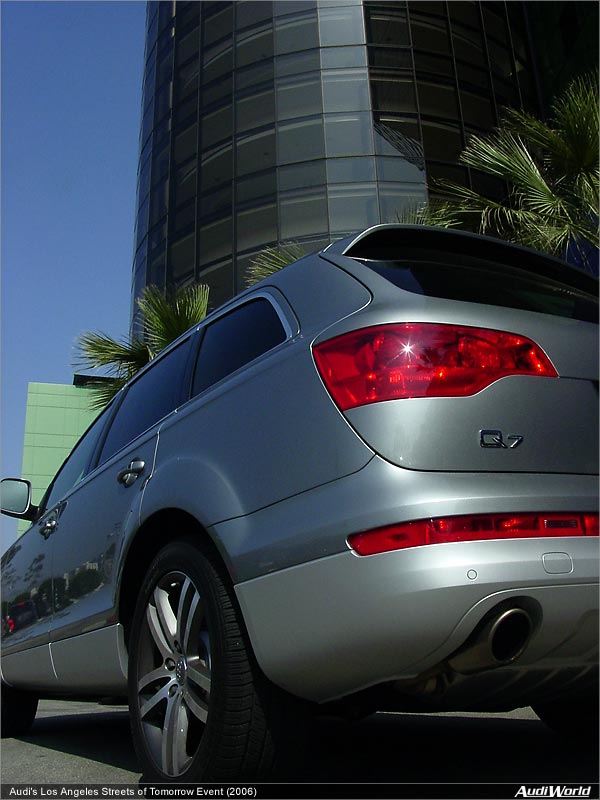Audi’s Los Angeles ‘Streets of Tomorrow’ Event

It was a warm and sunny Los Angeles Sunday afternoon. The sky was almost blue, muted only by the few dozen metric tons of carbon monoxide in the air. The setting was perfect for a rare offering from an automobile company: an open house test drive event featuring its entire lineup of cars. It was called `Streets of Tomorrow’ and was presented by Audi. You wouldn’t know that Audi wasn’t LA’s top premium brand judging by the attendance, which sold out quickly after the event announcement. Audi brought in more vehicles and staff to eventually allow more eager attendees, their guests and even toddlers to enjoy the day. But thankfully Audi forbade any yapping miniaturized dogs which have become such a common fashion accessory. The location was the fittingly high-tech Pacific Design Center, located in West Hollywood. The actual event concentrated on the sprawling glass and metal landmark’s back parking lot and entrance. To the right side of the large doors were a fleet of 4.2 Q7’s queued in a single-file line ready for test-driving. The large SUV’s looked very handsome, if not a bit imposing, with their military-like positioning making them appear ready to invade a small country. The Q7 is indeed a very impressive looking vehicle, and is downright gorgeous when standing next to its rather frumpy and relatively out-dated looking competing vehicles (a BMW and Volvo) that Audi willingly brought in for the guests to compare. Populating the parking lot were various parked Audi sedans, wagons, a TT, and an A4 Cabriolet. There was a constant circuit of people entering and exiting cars in front of the entrance. I heard several comments, generally positive, such as one woman gushing “That’s a GREAT car!” as she stepped out of an A8. Every couple of minutes the crowd would quiet down and stare in synchronized awe as a North American spec RS4 would roll in to unload its latest posse of passengers. The car has a downright erotic sound to its exhaust; moaning a seductive mix of large-displacement burbling and jet engine wheezing. Amazing. The RS4 was the only car that could not be driven by a guest. Instead Audi offered passenger-only experiences of the supercar. Even with that limitation the waiting list averaged almost 2 hours. Inside, Audi assembled an appropriately premium-feeling environment for people to wait as their cars were being readied. A slick reception area gave way to an even slicker (if not somewhat 90’s looking) Bang & Olufsen fitted mock living room not unlike an Ikea showroom. There was a separate room where a jazz band played live music, although no one actually sat to watch the performance. Of most interest were 3 vehicles on display: A Q7, an S8, and the multiple Le Mans-winning R8. The V10-fitted S8 was extraordinarily luxurious inside. It had the very best of interior options: a Bang & Olufsen million speaker setup, acres of Alcantara stretched across the entire headliner and door inserts, premium double-stitched leather, and carbon fiber replacing the usual wood surface areas. It was one of the most sublimely luxurious environments I had ever immersed myself in. However the cockpit’s most mouth-watering component was the dash illuminating a 300km speedo and 8000 rpm limit. This is a true exotic sports sedan, representing the very best of Audi: high luxury and high performance.
Test Drive: the Q7 Audi offered three test-drive choices so long as one of the choices was the Q7. So much for freedom of choice when big corporations are concerned. I was determined to suspend my distaste for SUV’s (they are statistically far more dangerous and polluting than regular cars), and give Audi’s gigantic SUV a fair shake. Instructed to safely drive the premium packaged 4.2-liter Q7 around a short route within the streets of West Hollywood, I made sure to nevertheless take advantage of any open spaces to push the vehicle. To my surprise, the truck handled very much like a regular car. There was little body roll when jerking the Q7 laterally lane-to-lane. The throttle response was virtually instant (impressive for a Tiptronic) and very linear throughout the rev range. I won’t mention any names, but an Audi rep seated in a neighboring A4 Cabriolet encouraged me to a street race. The 5000+ pound SUV easily thrashed the convertible. Mind you the A4 was only a 1.8T. My guest in the back seat was impressed by the thoughtful details, such as the b-pillar mounted air vents. The Q7 does sacrifice a trifle amount of typical Audi quality to keep the truck from accumulating a Cayenne-level sticker. Subtle omissions such as the lack of soft felt on the unseen inside part of the door pockets insinuated that Audi needed to cut corners here and there to keep this otherwise superior SUV aggressively priced. The Q7’s single most impressive feature was its 4.2-liter V8. I had tested a previous iteration of the engine before (on the 330hp A6 4.2) and was not expecting much difference. But this engine is a significant step up. The upgrade to FSI direct injection has not only encouraged more horsepower (350 ponies) but also given the already magnificent engine dramatically more torque that rivals even the RS4 (325 lb-ft). The result is a very muscular power plant with an even, seemingly endless flow of power. It will be interesting to experience this superb engine when it makes its way into some lighter Audi vehicles such as next year’s A8 and A6, and eventually the S4.
A3 vs. A3 My next test-drives involved comparing the 2 engines available for the A3: the 2.0T and 3.2. There have been a few reviews criticizing the 3.2 for being somewhat disappointing when compared to A3’s 2.0T. The initial 4-cylinder turbo variant made a big splash when it hit American soil last year, attaining very high praise such as inclusion as one of Car & Driver’s top 10 best cars of 2005. First up was the 2.0T DSG. I was very eager to play with the much-lauded double clutch transmission and was for the most part very impressed. Gear-shifts were, on the whole, lightning-quick. However sometimes there was a delay – probably due to a combination of slight turbo lag coupled with the system pre-selecting the opposite gear that I chose via the very well designed paddle shifters. The most noticeable amount of turbo lag was felt when pushing the throttle hard from a stand-still. There was a momentary delay as the turbo spooled up, but then the car went off like a rocket. As impressive as the DSG was, I would have preferred a manual transmission mated to this engine. Like a manual A4 2.0T I recently tested, a stick could easily disguise turbo lag due to its ability to rev the engine up before launching the car. The car did feel nimble, even with two other passengers riding along. My other reservation came from the A3’s relatively economy feeling interior. Even though the A3’s interior is easily ahead of its compact-hatch competition in terms of refinement, it still seamed a little low on that ever-so-elusive-feel-good factor that Audi is famous for. Then again, I had been in the granddaddy of executive cars just minutes earlier (the jaw-dropping S8), so I suppose most cars would have seemed anti-climactic by comparison. Next up was the A3 3.2. With the same amount of passengers, the car felt only slightly faster than the 2.0T in terms of acceleration. This was not so surprising considering the little car gained several hundreds of pounds of metal in the form of Haldex quattro and a steel-bodied VW 6 cylinder engine (not the same as Audi’s acclaimed aluminum 3.2 V6). Yet despite only moderate gains in straight-line performance, the 3.2 was a far superior car overall. First and foremost, the DSG worked brilliantly with the V6: no turbo lag, no delays. Acceleration from standstill was almost instantaneous. Power delivery was less peaky but more even. quattro gave me the confidence to push the car very hard around corners with only a touch of wheel spin, something the front-drive 2.0T could not accomplish without excessive tire squealing and fishtailing. There is of course a downside to all this extra weight and power: the car’s trip computer displayed an average fuel economy for the day of 12 miles per gallon. There was no way to tell what kind of antics the other guests pulled to merit such a low number, not to mention my own boy-racer driving style, but I was disappointed by its apparent SUV-level gas consumption. To be fair, this wasn’t a properly setup test drive, so the fuel economy statistics mentioned are probably off the mark. Overall, I preferred the A3 3.2 over 2.0T due to the larger engine’s beefy and linear delivery, a more predictable DSG, and of course quattro. But I wonder how many people would want to pay so much for a top of-the-line hatchback when they could get, for the same price, a larger A4 2.0T with a more refined interior and superior Torsen quattro. With DSG on the A3’s side, it’s probably a toss-up.
Audi’s bright yet smoggy future With North America being the company’s largest market, Audi has done well to invest in such a direct and generous marketing campaign. The German company has finally given in to American tastes with the Q7. It’s a massive, cupholder-laden monster that brilliantly melds European style, sophistication and dynamics with brute-force American decadence. And since statistics show that premium SUV’s will continue to sell well despite soaring gas prices, Audi is poised to bump itself up a notch or two in overall brand popularity by decade’s end. |



